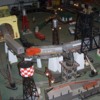SP AC-5 assembly (cont)
As with the AC-4, checking for binds were done along each step of the assembly of each drive engine set. Some side rod screws can have longer shoulders than others. The shorter shoulders are used on the ends of the side rods where the longer shoulders are used for the center drivers where two side rods over lap.
The tops of the side rods always have 'grease points' so they should always be pointing 'up'.
Usually, I find it easiest to take the support mechanism off while installing all the linkages. With all the linkages being plated, it is usually best to remove them so the other parts can be properly (easily) painted.
The offset crank is usually secured with a small set screw but, in this case, it is soldered onto the crank shaft.
The same with the screws that hold the linkages to the support mechanism: usually screws are used but this model had them soldered on. Some heat on the back will usually free the 'screws' and vise versa to get them back on.
Since the previous AC-4 needed an extra spring to hold up the added weight to the boiler, I added the same 'mod' to this engine.
Interesting brushes on this very large motor in that they are just two brass contacts.
Sometimes the manufacturer just uses some tubing to connect the motor to the gear box but, in this case, high quality universals are used.








